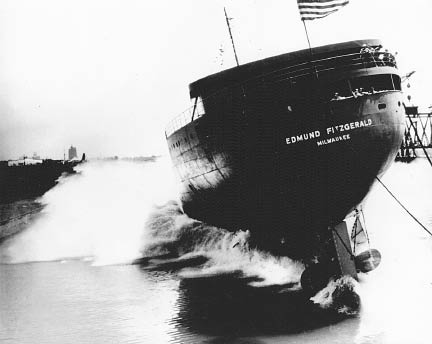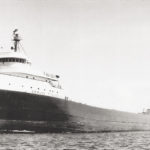Almost 36 years after the Edmund Fitzgerald sank to the bottom of Lake Superior, taking its 29 crew members with her, mystery still surrounds just what happened on Sunday, Nov. 9, 1975 to sink the 729-foot freighter.
The U.S. Coast Guard investigation laid the blame on the crew not properly securing the hatches, but their findings were met with skepticism. After the inquiry, the question remained: What caused the sinking of the Edmund Fitzgerald?
Two internationally known Canadian divers think they may have the answer. So compelling was their case on the TV documentary series “Dive Detectives” that singer/songwriter Gordon Lightfoot revised some of the lyrics of his ballad, “The Wreck of the Edmund Fitzgerald.”
For 17 years, the Fitzgerald was the “Pride of the American Flag,” setting all kinds of tonnage and shipping records. On Nov. 9, 1975, when she sailed out onto Lake Superior from Superior, Wis. with veteran mariner Capt. Ernest McSorley in command, she had already logged a total of 748 voyages and sailed over one million miles. It was her 17th winter of battling the November storms on the Great Lakes. But the storm she would experience in the coming hours would be so intense, so ferocious, that even Capt. McSorley commented it was “one of the worst seas” he had ever seen.
By 7 p.m. the next day (Nov. 10), the battered ship had a bad list, had lost both radars and was taking heavy seas. She was about 14 miles from the safe harbour of Whitefish Bay, just a little over 90 minutes of sailing time.
At 7:10 p.m., when asked how they were making out, Capt. McSorley told the Arthur M. Anderson—which was sailing about 10 miles behind her—replied, “We are holding our own.” It was the last time anyone heard from the Fitzgerald. By 7:15 pm, the Edmund Fitzgerald and her crew of 29 had disappeared.
Last year, after leading their own research and investigation into the sinking of the Edmund Fitzgerald, including simulating the actual weather and sea conditions, Canadians Mike Fletcher and his son Warren concluded that a rogue wave delivered the final blow to an already damaged ship. Their findings support what Capt. Jessie “Bernie” Cooper of the Arthur M. Anderson experienced shortly before they lost contact with the Fitzgerald.
Cooper and his First Mate had been watching their radar closely when they felt an unexpected bump. The Anderson lurched. It was then they saw a huge wave pouring green water over their entire vessel.
Fighting the water, the crew got the ship’s bow back up, but then, Cooper recalled, “Another wave just like the first one or bigger hit us again.” The massive waves slammed the Anderson, and then raced toward the wounded Fitzgerald, travelling a mile a minute. If they continued on course, the super waves would have hit the Fitzgerald 10 minutes later. Cooper’s observations seem to support the rogue wave theory of the Fletchers.
So do the results of the U.S. National Oceanic and Atmospheric Administration (NOAA) when a few years ago they recreated the Fitzgerald storm using 21st-century tools. NOAA concluded the storm’s worst marine conditions occurred briefly in a small specific area of Lake Superior—and that location was “coincident with the time and location at which the ship Edmund Fitzgerald was lost.”
In other words, Lake Superior’s perfect storm window was short, but was big enough to swallow the Fitzgerald—an ailing ship in the wrong place at the wrong time.
Read more about the Edmund Fitzgerald.




